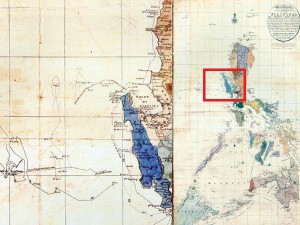Philippines-China standoff could spin out of hand

European cartographers named Scarborough Shoal as “Bajo Scarburo” in this 1820 map from the book “Mapping the Philippines: The Spanish Period.”
MANILA, Philippines — It started like many other minor confrontations over the specks of isles dotting some of the world’s busiest shipping lanes. But the risks in the latest flare-up over a South China Sea shoal are much bigger than the territory itself.
Armed vessels from the Philippines and its much more powerful neighbor, China, have faced off for two weeks at the horseshoe-shaped Scarborough Shoal. Either side could miscalculate — and consequences could bear down on the whole region, and drag in the US too.
Here’s a look at the key players, issues and what’s at stake:
HOW IT STARTED:
The Philippine navy says it caught Chinese fishermen poaching, and on April 10 two Chinese vessels moved in to protect them. The fishing boats slipped away, leaving behind a tense standoff with each side hoping the other will pull out first.
HISTORY OF FLASHPOINTS:
The shoal is among 200 islands, coral outcrops and banks spread over the South China Sea, with rich fishing grounds and other resources. The biggest of them are the Spratlys, claimed all or in part by the Philippines, China, Taiwan, Malaysia, Brunei and Vietnam.
There have been sporadic shootouts at sea in the past few decades — China-Vietnam, China-Philippines, Taiwan-Vietnam and Philippines-Vietnam — with navies sinking ships and fortifying disputed islands. A major clash in 1988 between China and Vietnam killed 64 Vietnamese soldiers. China took over the Philippine-occupied Mischief Reef in a surprise mini-invasion in 1995.
Then in 2002, all parties agreed to a status quo.
It largely held. Until now.